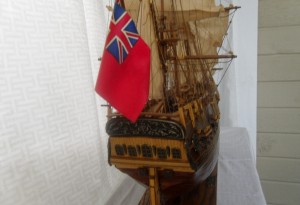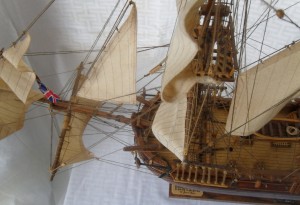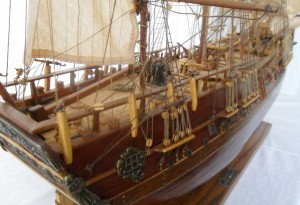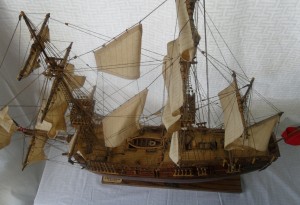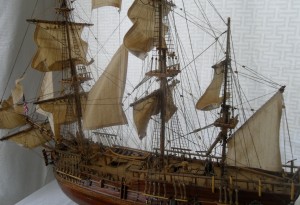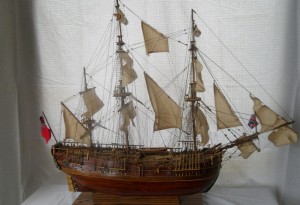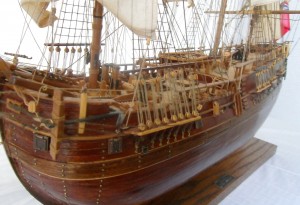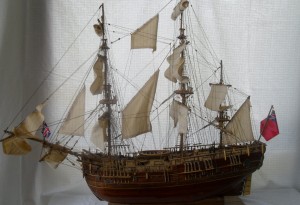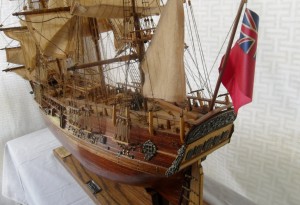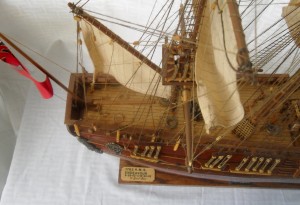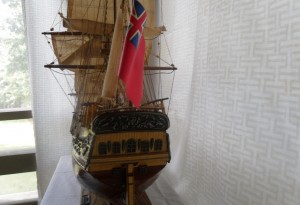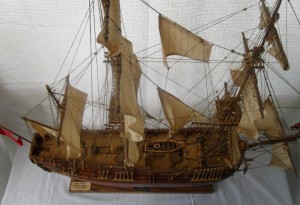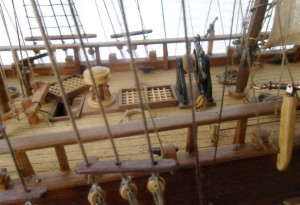Boat Name: HMS Endeavour
Year Launched: 1764
Country: Great Britain
Guns: 22
Actual Dimensions of Model: Length 32 inches, Height 28 inches.
Year Model Built: August 28, 2002- October 24, 2002
Model Construction Hours: 355 Hours
Historical Significance:
HMS Endeavour, also known as HM Bark Endeavour, was a British Royal Navy research vessel commanded by Lieutenant James Cook on his first voyage of discovery, to Australia and New Zealand from 1769 to 1771.
Launched in 1764 as the collier Earl of Pembroke, she was purchased by the Navy in 1768 for a scientific mission to the Pacific Ocean, and to explore the seas for the surmised Terra Australis Incognita or “unknown southern land”. Renamed and commissioned as His Majesty’s Bark the Endeavour, she departed Plymouth in August 1768, rounded Cape Horn, and reached Tahiti in time to observe the 1769 transit of Venus across the Sun.
She then set sail into the largely uncharted ocean to the south, stopping at the Pacific islands of Huahine, Borabora, and Raiatea to allow Cook to claim them for Great Britain. In September 1769, she anchored off New Zealand, the first European vessel to reach the islands since Abel Tasman’s Heemskerck 127 years earlier. In April 1770, Endeavour became the first seagoing vessel to reach the east coast of Australia, when Cook went ashore at what is now known as Botany Bay.
Endeavour then sailed north along the Australian coast. She narrowly avoided disaster after running aground on the Great Barrier Reef, and was beached on the mainland for seven weeks to permit rudimentary repairs to her hull. On 10 October 1770, she limped into port in Batavia (now named Jakarta) in the Dutch East Indies for more substantial repairs, her crew sworn to secrecy about the lands they had discovered. She resumed her westward journey on 26 December, rounded the Cape of Good Hope on 13 March 1771, and reached the English port of Dover on 12 July, having been at sea for nearly three years.
Largely forgotten after her epic voyage, Endeavour spent the next three years shipping Navy stores to the Falkland Islands. Renamed and sold into private hands in 1775, she briefly returned to naval service as a troop transport during the American Revolutionary War and was scuttled in a blockade of Narragansett Bay, Rhode Island in 1778. Her wreck has not been precisely located, but relics, including six of her cannons and an anchor, are displayed at maritime museums worldwide.
A replica of Endeavour was launched in 1994 and is berthed alongside the Australian National Maritime Museum in Sydney Harbour. The space shuttle Endeavour is named for the original ship. Endeavour features on the New Zealand fifty cent piece in recognition of its significant place in the nation’s history.
